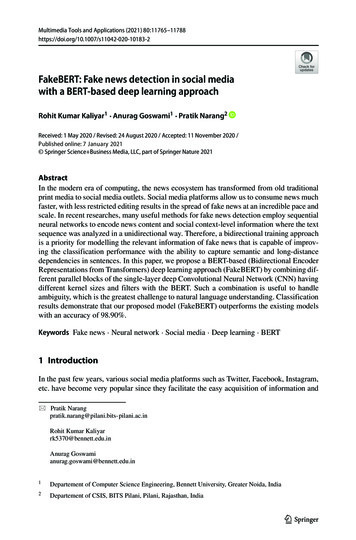
Transcription
Multimedia Tools and Applications (2021) -10183-2FakeBERT: Fake news detection in social mediawith a BERT-based deep learning approachRohit Kumar Kaliyar1 · Anurag Goswami1 · Pratik Narang2Received: 1 May 2020 / Revised: 24 August 2020 / Accepted: 11 November 2020 /Published online: 7 January 2021 Springer Science Business Media, LLC, part of Springer Nature 2021AbstractIn the modern era of computing, the news ecosystem has transformed from old traditionalprint media to social media outlets. Social media platforms allow us to consume news muchfaster, with less restricted editing results in the spread of fake news at an incredible pace andscale. In recent researches, many useful methods for fake news detection employ sequentialneural networks to encode news content and social context-level information where the textsequence was analyzed in a unidirectional way. Therefore, a bidirectional training approachis a priority for modelling the relevant information of fake news that is capable of improving the classification performance with the ability to capture semantic and long-distancedependencies in sentences. In this paper, we propose a BERT-based (Bidirectional EncoderRepresentations from Transformers) deep learning approach (FakeBERT) by combining different parallel blocks of the single-layer deep Convolutional Neural Network (CNN) havingdifferent kernel sizes and filters with the BERT. Such a combination is useful to handleambiguity, which is the greatest challenge to natural language understanding. Classificationresults demonstrate that our proposed model (FakeBERT) outperforms the existing modelswith an accuracy of 98.90%.Keywords Fake news · Neural network · Social media · Deep learning · BERT1 IntroductionIn the past few years, various social media platforms such as Twitter, Facebook, Instagram,etc. have become very popular since they facilitate the easy acquisition of information and Pratik Narangpratik.narang@pilani.bits-pilani.ac.inRohit Kumar Kaliyarrk5370@bennett.edu.inAnurag Goswamianurag.goswami@bennett.edu.in1Departement of Computer Science Engineering, Bennett University, Greater Noida, India2Departement of CSIS, BITS Pilani, Pilani, Rajasthan, India
11766Multimedia Tools and Applications (2021) 80:11765–11788Fig. 1 Examples of some fake news spread over social media (Source: Facebook )provide a quick platform for information sharing [10, 21]. The availability of unauthenticdata on social media platforms has gained massive attention among researchers and becomea hot-spot for sharing fake news [16, 46]. Fake news has been an important issue due toits tremendous negative impact [16, 46, 53], it has increased attention among researchers,journalists, politicians and the general public. In the context of writing style, fake news iswritten or published with the intent to mislead the people and to damage the image of anagency, entity, person, either for financial or political benefits [14, 35, 39, 53]. Few examplesof fake news are shown in Fig. 1. These examples of fake news were in trending during theCOVID-19 pandemic and 2016 U.S. General Presidential Election.In the research context, related synonyms (keywords) often linked with fake news:––Rumor: A rumour [4, 12, 16] is an unverified claim about any event, transmitting fromindividual to individual in the society. It might imply to an occurrence, article, andany social issue of open public concern. It might end up being a socially dangerousphenomenon in any human culture.Hoax: A hoax is a falsehood deliberately fabricated to masquerade as the truth [43].Currently, it has been increasing at an alarming rate. Hoax is also known as with similarnames like prank or jape.1.1 Existing approaches for fake news detectionDetection of fake news is challenging as it is intentionally written to falsify information.The former theories [1] are valuable in guiding research on fake news detection using different classification models. Existing learnings for fake news detection can be generallycategorized as (i) News Content-based learning and (ii) Social Context-based learning.News content-based approaches [1, 14, 51, 53] deals with different writing style of published news articles. In these techniques, our main focus is to extract several features infake news article related to both information as well as the writing style. Furthermore, fakenews publishers regularly have malignant plans to spread mutilated and deluding, requiringspecific composition styles to interest and convince a wide extent of consumers that are notpresent in true news stories. In these learnings, style-based methodologies [12, 35, 53] arehelpful to capture the writing style of manipulators using linguistic features for identifying
Multimedia Tools and Applications (2021) 80:11765–1178811767Fig. 2 Approaches for fake news detectionfake articles. Thus, it is difficult to detect fake news more accurately by using only newscontent-based features [14, 33, 46]. Thus, we also need to investigate the engagement offake news articles with users.Social context-based approaches [14, 17, 38, 51, 53] deals with the latent informationbetween the user and news article.Social engagements (the semantic relationship betweennews articles and user) can be used as a significant feature for fake news detection. Inthese approaches, instance-based methodologies [51] deals with the behaviour of the usertowards any social media post to induce the integrity of unique news stories. Furthermore,propagation-based methodologies [51] deals with the relations of significant social mediaposts to guide the learning of validity scores by propagating credibility values betweenusers, posts, and news. Approaches related to fake news detection show in Fig. 2. In mostof the existing and useful methods [14, 38, 51] consists of news content and context levelfeatures using unidirectional pre-trained word embedding models (such as GloVe, TF-IDF,word2Vec, etc.) There is a large scope to use bidirectional pre-trained word embeddingmodels having powerful feature extraction capability.1.2 Our contributionIn the existing approaches [1, 33, 40], for the detection of fake news, many useful methodshave been presented using traditional machine learning models. The primary advantage ofusing deep learning model over existing classical feature-based approaches is that it doesnot require any handwritten features; instead, it identifies the best feature set on its own. Thepowerful learning ability of deep CNN is primarily due to the use of multiple feature extraction stages that can automatically learn representations from the dataset. In the existing
11768Multimedia Tools and Applications (2021) 80:11765–11788approaches [18, 19, 26], several inspiring ideas have been discussed to bring advancementsin deep Convolutional Neural Networks(CNNs) like exploiting temporal and channel information, depth of architecture, and graph-based multi-path information processing. The ideaof using a block of layers as a structural unit is also gaining popularity among researchers.In this paper, we propose a BERT-based deep learning approach (FakeBERT) by combiningdifferent parallel blocks of the single-layer CNNs with the Bidirectional Encoder Representations from Transformers (BERT). We utilize BERT as a sentence encoder, which canaccurately get the context representation of a sentence. This work is in contrast to previous research works [9] where researchers looked at a text sequence in a unidirectionalway (either left to right or right to left for pre-training). Many existing and useful methodshad been [9, 24] presented with sequential neural networks to encode the relevant information. However, a deep neural network with bidirectional training approach can be anoptimal and accurate solution for the detection of fake news. Our proposed method improvesthe performance of fake news detection with the powerful ability to capture semantic andlong-distance dependencies in sentences.To design our proposed architecture, we have added a classification layer on the topof the encoder output, multiplying the output vector by the embedding matrix, and finallycalculated the probability of each vector with the Softmax function. Our model is a combination of three parallel blocks of 1D-convolutional neural networks with BERT havingdifferent kernel sizes and filters following by a max-pooling layer across each block. Withthis combination, the documents were processed using different CNN topologies by varying kernel size (different n-grams), filters, and several hidden layers or nodes. The designof FakeBERT consists of five convolution layers, five max-pooling layers followed by twodensely connected layers and one embedding layer (BERT-layer) of input. In each layer,several filters have been applied to extract the information from the training dataset. Such acombination of BERT with one-dimensional deep convolutional neural network (1d-CNN)is useful to handle large-scale structure as well as unstructured text. It effectively addressesambiguity, which is the greatest challenge to natural language understanding. Experimentswere conducted to validate the performance of our proposed model. Several performanceevaluation parameters (training accuracy, validation accuracy, False Positive Rate (FPR),and False Negative Rate (FNR)) have been taken into consideration to validate the classification results. Extensive experimentations demonstrate that our proposed model outperformsas compared to the existing benchmarks for classifying fake news. We illustrate the performance of our bidirectional pre-trained model (BERT) achieved an accuracy of 98.90%. Ourproposed approach produces improved results by 4% comparing to the baseline approachesand is promising for the detection of fake news.2 Related workThis section briefly summarizes the work in the field of fake news detection. Kumar et al[21] have explored a comprehensive survey of diverse aspects of fake news. Different categories of fake news, existing algorithms for counterfeit news detection, and future aspectshave been explored in this research article. In one of the research, Shin et al [37] haveinvestigated about fundamental theories across various disciplines to enhance the interdisciplinary study of fake news. In their study, authors have mainly investigated the problemof fake news from four prospectives: False knowledge it carries (what type of false messageyou get from the content), writing styles(different writing styles for creating fake news),
Multimedia Tools and Applications (2021) 80:11765–1178811769propagation patterns (when it is shared in a network, then which trends it follows), and thecredibility of its creators and spreaders (the credibility score of a news creator and spreader).Bondielli et al [4] have presented a hybrid approach for detecting automated spammersby amalgamating community-based features with other feature categories, namely metacontent and interaction-based features. In another research, Ahmed et al [1] have focused onautomatic detection of fake content using online fake reviews. Authors have also exploredtwo different feature extraction methods for classifying fake news. They have examined sixdifferent machine learning models and shown improved accomplishments as compared toexisting state-of-the-art benchmarks. In one of the researches, Allcott et al [2] have focusedon a quantitative report to understand the impact of fake news on social media in the 2016U.S. Presidential General Election and its effect upon U.S. voters. Authors have investigatedthe authentic and unauthentic URLs related to fake news from the BuzzFeed dataset. In oneof the studies, Shu et al [38] have investigated a way for robotization process through hashtag recurrence. In this research article, authors have also presented a comprehensive reviewof detecting fake news on social media, false news classifications on psychology and socialconcepts, and existing algorithms from a data mining perspective. Ghosh et al [14] haveinvestigated the impact of web-based social networking on political decisions. Quantityresearch [2, 53, 54] has been done in the context of detecting political-news-based articles.Authors have investigated the effect of various political gatherings related to the discussion of any fake news as agenda. Authors have also explored the Twitter-based data of sixVenezuelan government officials with a specific end goal to investigate bot collaboration.Their discoveries recommend that political bots in Venezuela tend to imitate individualsfrom political gatherings or basic natives.In one of the studies, Zhou et al [53] have investigated the ability of social media toaggregate the judgments of a large community of users. In their further investigation, theyhave explained machine learning approaches with the end goal to develop a better rumoursdetection. They have investigated the difficulties for the spread of rumours, rumours classification, and deception for the advancement of such frameworks. They have also investigatedthe utilization of such useful strategies towards creating fascinating structures that can helpindividuals in settling on choices towards evaluating the integrity of data gathered from various social media platforms. Vosoughi et al [46] have recognized salient features of rumoursby investigating three aspects of information spread online: linguistic style, characteristicsof people involved in propagating information, and network propagation subtleties. Authorshave analyzed their proposed algorithm on 209 rumours representing 938,806 tweets collected from real-world events, including the 2013 Boston Marathon bombings, the 2014Ferguson unrest, and the 2014 Ebola epidemic. They have expressed the effectiveness oftheir proposed framework with all existing methods. The primary objective of their studywas to introduce a novel way of assessing style-similarity between different text contents.They have implemented numerous machine learning models and achieved an accuracy of51% for fake news detection.Chen et al [7] have proposed an unsupervised learning model combining recurrent neuralnetworks and auto-encoders to distinguish rumours as anomalies from other credible microblogs based on users’ behaviours. The experimental results show that their proposed modelwas able to achieve an accuracy of 92.49% with an F1 score of 89.16%. Further, Yanget al [49] have arrived with comparative resolutions for detecting false rumours. Duringthe 2011 riots in England, authors have noticed and investigated that any improvement inthe false rumours based stories could produce good results. In their investigation of the2013 Boston Marathon bombings, they have found some exciting news stories, and most
11770Multimedia Tools and Applications (2021) 80:11765–11788of them were rumours and produced a significant impact on the share market. Shu et al[39] have explored the connection between fake and real facts available on social mediaplatforms using an open tweet dataset. This dataset was created by gathering online tweetsfrom Twitter that contains URLs from reality checking facts. In their investigation, they havefound that URL’s are the most widely recognized strategy to share news articles on variousstages for the measurement of client articulation (for example, Twitter’s limit is with 140characters constraint). In their further investigation, they have used a Hoax-based datasetthat gives a more accurate prediction for distinguishing fake news stories by conflictingthem against known news sources from renowned inspection sites.In one of the researches, Monteiro et al [25] have collected a fake news dataset in thePortuguese language and investigated their results based on different linguistic features.Authors have achieved the highest accuracy of 49% using machine learning techniques.One of the researches, Karimi et al [20] have analyzed 360 satirical news articles including civics, science, business, and delicate news. They have also proposed an SVM-basedmodel. In their investigation, their five highlights are Absurdity, Humor, Grammar, Negative effect, and punctuation. Their proposed framework achieved an accuracy of 38.81%.One of the researches, Perez-Rosas et al [29] have explained the automatic identificationof fake content in online news articles. They have presented a comprehensive analysis forthe identification of linguistic features in the false news content. In one of the studies,Castillo et al [5] have investigated feature-based methods to assess the credibility of tweetson Twitter. Roy et al [34] have explored the neural embedding approach using the deeprecurrent model. They have used weighted n-gram bag of word model using statistical features and other external features with the help of featuring engineering. Subsequently, theyhave combined all features and classifying fake news with the accuracy of 43.82%. One ofthe researches, Wang et al [47] have presented a novel dataset for fake news detection. Theyhave proposed a hybrid architecture to solve fake news problem. They have created a modelusing two main components; one is a Convolutional Neural Network for meta-data representation learning, followed by a Long Short-Term Memory neural network (LSTM). Althoughbeing complicated with many parameters to be optimized, their proposed model performspoorly on the test set, with only 27.4% inaccuracy. One of the researches, Peters et al [30]took a different perspective on detecting fake news by looking at its linguistic characteristics. Despite substantial dependence on lexical resources, the performance on political-setwas even slower than [47], with an accuracy of 22.0% only.In many existing studies [13, 23, 28, 42], authors have explored the problem of fake newsemploying a real-world fake news dataset: Fake-News. In one of the studies, Ahmed et al [1]have utilised TF-IDF (Term Frequency-Inverse Document Frequency) as a feature extraction method with different machine learning models. Extensive experiments have performedwith LR (Linear-regression model) and obtained an accuracy of 89.00%. Subsequently, theyhave shown an accuracy of 92% using their LSVM (Linear Support Vector Machine). Liuet al [23] have investigated the methods for recognizing false tweets. In their investigation,authors have utilized a corpus of more than 8 million tweets gathered from the supportersof the presidential candidates in the general election in the U.S. In their investigation, theyhave employed deep CNNs for fake news detection. In their approach, they have utilised theconcept of subjectivity analysis and obtained an accuracy of 92.10%. O’Brien et al [28] haveapplied deep learning strategies for classifying fake news. In their study, they have achievedan accuracy of 93.50% using the black-box method. Ghanem et al [13] have adopted different word embeddings, including n-gram features to detect the stances in fake articles.They have obtained an accuracy of 48.80%. Ruchansky et al [35] have employed a deep
Multimedia Tools and Applications (2021) 80:11765–1178811771hybrid model for classifying fake news. They have utilized news-user relationships as anessential factor and achieved an accuracy of 89.20%. In one of the studies, Singh et al [42]have investigated with LIWC (Linguistic Analysis and Word Count) features using traditional machine learning methods for classifying fake news. They have explored the problemof fake news with SVM (support vector machine) as a classifier obtained an accuracy of87.00%. In one of the studies, Jwa et al [18] have explored the approach towards automaticfake news detection. They have used Bidirectional Encoder Representations from Transformers model (BERT) model to detect fake news by analyzing the relationship between theheadline and the body text of the news story. Their results improve the 0.14 F-score overexisting state-of-the-art models. Weiss et al [48] have investigated the origins of the term“fake news” and the factors contributing to its current prevalence. This lack of consensusmay have future implications for students in particular and higher education. Crestani et al[8] have proposed a novel model that can classify a user as a potential fact checker or apotential fake news spreader. Their model was based on a Convolutional Neural Network(CNN) and combined word embeddings with features that represent users’ personality traitsand linguistic patterns.3 MethodologyIn this section, an overview of word embedding, GloVe word embedding, BERT model,fine-tuning of BERT, and the selection of hyperparameters discussed. Our proposed model(FakeBERT) and other deep learning architectures also investigated in this section.3.1 Word embeddingWord embeddings [30] are widely used in both machine learning as well as deep learningmodels. These models perform well in cases such as reduced training time and improvedoverall classification performance of the model. Pre-trained representations can also eitherbe static or contextual (refer Fig. 3 for more details). Contextual models generate a representation of each word that is based on the other words in the sentence. Word2Vec andGloVe [50] are currently among the most widely used word embedding models that can convert words into meaningful vectors. For using pre-trained embedding models for training,we displace the parameters of the processing layer with input embedding vectors. Primarily,we maintain the index and then fix this layer, restricting it from being updated throughoutthe method of gradient descent [30, 31]. Our experiment shows that embedding-based inputvectors perform a valuable role in text classification tasks.3.2 GloVeThe GloVe is a weighted least square model [3] that train the model using co-occurrencecounts of the words in the input vectors. It effectively leverages the benefits of the statisticalinformation by training on the non-zero elements in a word-to-word co-occurrence matrix.The GloVe is an unsupervised training model that is useful to find the co-relation betweentwo words with their distance in a vector space [31]. These generated vectors are known asword embedding vectors. We have used word embedding as semantic features in additionto n-grams because they represent the semantic distances between the words in the context. The smallest package of embedding is 822Mb, called “glove.6B.zip”. GloVe modelis trained on a dataset having one billion words with a dictionary of 400 thousand words.
11772Multimedia Tools and Applications (2021) 80:11765–11788Fig. 3 An Overview of existing word-embedding modelsThere exist different embedding vector sizes, having 50, 100, 200 and 300 dimensions forprocessing. In this paper, we have taken the 100-dimensional version.3.3 BERTBERT [11] is a advanced pre-trained word embedding model based on transformer encodedarchitecture [44]. We utilize BERT as a sentence encoder, which can accurately get thecontext representation of a sentence [30]. BERT removes the unidirectional constraint usinga mask language model (MLM) [44]. It randomly masks some of the tokens from the inputand predicts the original vocabulary id of the masked word based only. MLM has increasedthe capability of BERT to outperforms as compared to previous embedding methods. Itis a deeply bidirectional system that is capable of handling the unlabelled text by jointlyconditioning on both left and right context in all layers. In this research, we have extractedembeddings for a sentence or a set of words or pooling the sequence of hidden-states for thewhole input sequence. A deep bidirectional model is more powerful than a shallow left-toright and right-to-left model. In the existing research [11], two types of BERT models havebeen investigated for context-specific tasks, are:––BERT Base (refer Table 1 for more information about parameters setting): Smaller insize, computationally affordable and not applicable to complex text mining operations.BERT Large (refer Table 2 for more information about parameters setting): Larger insize, computationally expensive and crunches large text data to deliver the best results.3.4 Fine-tuning of BERTFine-tuning of BERT [11] is a process that allows it to model many downstream tasks, irrespective of the text form (single text or text pairs). A limited exploration is available toenhance the computing power of BERT to improve the performance on target tasks. BERTmodel uses a self-attention mechanism to unify the word vectors as inputs that includebidirectional cross attention between two sentences. Mainly, there exist a few fine-tuning
Multimedia Tools and Applications (2021) 80:11765–1178811773Table 1 Parameters for BERT-BaseParameter NameValue of ParameterNumber of Layers12Hidden Size768Attention Heads12Number of Parameters110Mstrategies that we need to consider: 1) The first factor is the pre-processing of long text sincethe maximum sequence length of BERT is 512. In our research, we have taken the sequencelength of 512. 2) The second factor is layer selection. The official BERT-base model consists of an embedding layer, a 12-layer encoder, and a pooling layer. 3) The third factoris the over-fitting problem. BERT can be fine-tuned with different learning parameters fordifferent context-specific tasks [44] (refer Table 2 for more information).3.5 Deep learning models for fake news detectionDeep learning models are well-known for achieving state-of-the-art results in a wide rangeof artificial intelligence applications [31]. This section provides an overview of the deeplearning models used in our research with their architectures to achieve the end goal. Experiments have been conducted using deep learning-based models (CNN and LSTM [15]) andour proposed model (FakeBERT) with different pre-trained word embeddings.a) Convolutional Neural Network (CNN): In Fig. 4, the computational graph of ourdesigned Convolutional Neural Network (CNN) model is shown. This CNN model (Fig. 4)truncates, zero-pads, and tokenizes the fake news article separately and passes each into anembedding layer. In this architecture (refer Table 3 and Fig. 4), first convolution layer holds128 filters with kernels size 5, which decreases the input embedding vector from 1000 to996 after convolution process. In the network, after each convolution layer, a max-poolinglayer is also present to reduce the input vector dimension. Subsequently, a max-poolinglayer with filter size 5; that further minimises the embedding vector to 1/5th of 996, i.e.199. The second convolution layer holds 128 filters with kernels size 5, which decreasesthe input embedding vector from 199 to 195. Subsequently, this is the max-pooling layerwith filter size 5; that further reduces the input vector to 1/5th of 199, i.e. 39. After threeconvolution layers, a flatten layer is added to convert 2-D input to 1-D. Subsequently, thereare two hidden layers having 128 neurons in each one. The outputs of the CNNs are passedthrough a dense layer with dropout and then passed through a softmax layer to yield a stanceclassification. Number of trainable parameters are also shown in Table 3.Table 2 Parameters for BERT-LargeParameter NameValue of ParameterNumber of Layers24Hidden Size1024Attention Heads16Number of Parameters340M
11774Multimedia Tools and Applications (2021) 80:11765–11788Fig. 4 CNN modelTable 3 CNN layered architectureLayerInput sizeOutput sizeParam numberEmbedding10001000 10025187700Conv1D1000 100996 12864128Maxpool996 128199 1280Conv1D199 128195 12882048Maxpool195 12839 1280Conv1D39 12835 12882048Maxpool35 1281 1280Flatten1 1281280Dense12812816512Dense1282258Table 4 LSTM layered architectureLayerInput sizeOutput sizeParam numberEmbedding1000 1001000 10025187700Dropout1000 1001000 1000Conv1D1000 1001000 3216032Maxpool1000 32500 320Conv1D500 32500 646208Maxpool500 64250 640LSTM250 5856Dense25612832896Dense128648256Dense642130
Multimedia Tools and Applications (2021) 80:11765–1178811775Fig. 5 FakeBERT modelb) Long Short Term Memory Network (LSTM): In this paper, we have implemented theLSTM model having four dense layers with a batch normalization process for the classification of fake news. The selection of optimal hyperparameters is also made for accurateresults. From Table 4, we can observe the layered architecture of the LSTM model.3.6 Proposed model: FakeBERTIn this paper, the most fundamental advantage of selecting a deep convolutional neural network is the automatic feature extraction. In our proposed model, we pass the input in theform of a tensor in which local elements correlates with one another. More concrete resultscan be achieved with a deep architecture which develops hierarchical representations oflearning. From Fig. 5, we can perceive the computational graph of our proposed approach(FakeBERT). In many existing and useful studies [6, 52], the problem of fake news hasexamined utilising a unidirectional pre-trained word embedding model followed by a 1Dconvolutional-pooling layer network [52]. Our suggested model obtains the advantages ofautomated feature engineering approach [36]. In our model, inputs are the vectors generated after word-embedding from BERT. We give the equal dimensional input vectors to allthree convolutional layers present in parallel blocks [26] followed by a pooling layer in eachblock. In our proposed model, the decision of chosen number of convolutional layers, kernels sizes, no. of filters, and optimal hyperparameters etc.[19, 26] to make our model moreaccurate as follows:Convolutional layer The convolutional layer consists of a set of filters and kernels [52] forbetter semantic representations of words having a different length. The significant actionsperformed are matrix multiplications (non-linear operation) passes through an activationfunction to produce the final output. In our propo
Fig.1 Examples of some fake news spread over social media (Source: Facebook ) provide a quick platform for information sharing [10, 21]. The availability of unauthentic data on social media platforms has gained massive attention among researchers and become a hot-spot for sharing fake news [16, 46]. Fake news has been an important issue due to



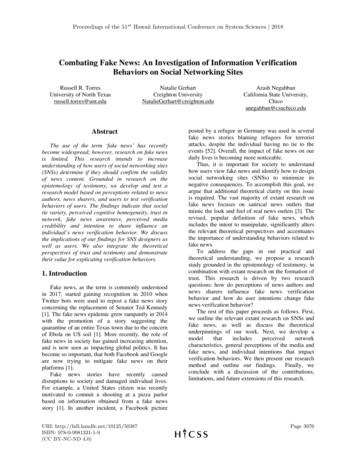
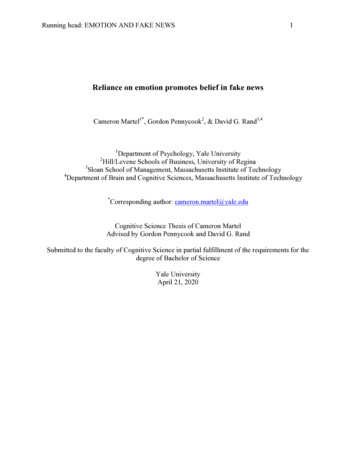
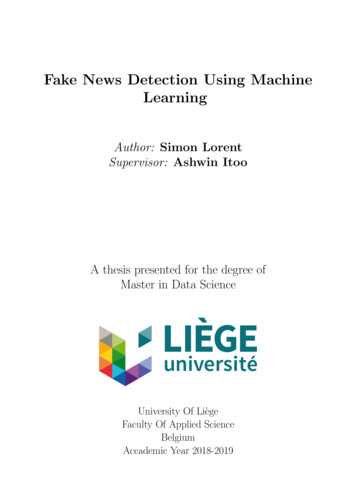

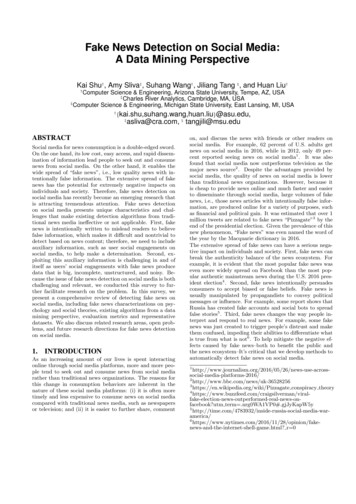
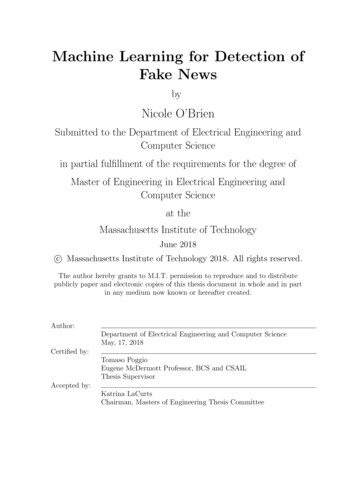
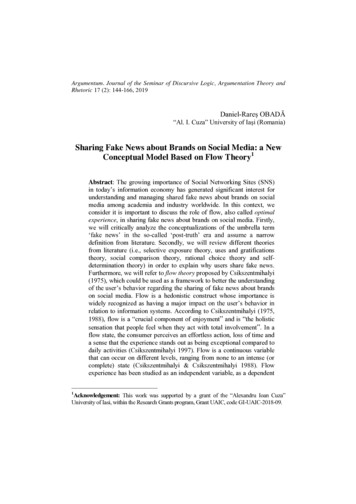
![Fake Notepad Crack Free X64 [Latest 2022]](/img/41/fake-notepad-crack-free-download-x64-latest-2022.jpg)